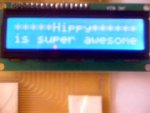So far I've had my 44780-compatible LCD working in the following setups:
Serial firmware from www.oatleyelectronics.com
18X-driven parallel operation as in the picaxe manual
14M-driven parallel operation as per Hippy's elegant code at http://www.picaxeforum.co.uk/showthread.php?p=67665
However I'm completely stumped when I try to get the LCD to work with a 20M. I've tried Hippy's code as per the 14M above, I've tried the code from the manual, no luck. Why would the 14M code not work with a 20M, with output pins 0 to 5 connected as per the 14M?
I notice that when I "simulate" the program on on the 20M all 8 pins have data going out - is it all relevant? Which 6 pins of these 8 actually contain the required data for the LCD?
Has anyone got an LCD to work with a 20M?
Oh and I just re-connected the 14M to my circuit to make sure I hadn't fried the LCD. It still works fine. With the 20M back in place, all I get is the top line filled with black squares, regardless of what program I am running on the 20M. I think this means the LCD is not even being initialised by the 20M?
Thanks for your help.
Nick.
Serial firmware from www.oatleyelectronics.com
18X-driven parallel operation as in the picaxe manual
14M-driven parallel operation as per Hippy's elegant code at http://www.picaxeforum.co.uk/showthread.php?p=67665
However I'm completely stumped when I try to get the LCD to work with a 20M. I've tried Hippy's code as per the 14M above, I've tried the code from the manual, no luck. Why would the 14M code not work with a 20M, with output pins 0 to 5 connected as per the 14M?
I notice that when I "simulate" the program on on the 20M all 8 pins have data going out - is it all relevant? Which 6 pins of these 8 actually contain the required data for the LCD?
Has anyone got an LCD to work with a 20M?
Oh and I just re-connected the 14M to my circuit to make sure I hadn't fried the LCD. It still works fine. With the 20M back in place, all I get is the top line filled with black squares, regardless of what program I am running on the 20M. I think this means the LCD is not even being initialised by the 20M?
Thanks for your help.
Nick.



